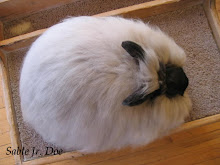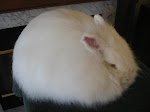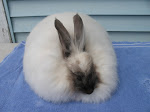I have heard lots of good things over the years about crossing the New Zealand breed with the French Angora breed, so about a year and a half ago I decided to try it out for myself:). I acquired an F2 FA/NZ doe from a friend of mine, and began working it into my purebred herd, keeping every breeding separate and carefully documenting the results.
The main reason for introducing a New Zealand into any commercial breed, of course, is to improve the overall type. Anyone who has ever had their hands on a well-bred NZ can certainly appreciate the desire to transfer those qualities of width and depth into their own animals, and while the FA type has been improving steadily according to judges, it is still not equal to a really excellent meat rabbit.
Many people would argue that type is NOT the primary focus in the angora breeds, and it is certainly true that of the points allotted to each breed, only 35 are ascribed to type in the FA. Wool is unquestionably 'Job 1' in all the angora breeds, but it is also true that a poorly typed French will not be able to perform on the show table, and it has no hope at all of being placed on a national level. The commercial type of our breed is both a blessing and a curse, IMO. It is a blessing because it enables the FA (and the SA and GA) to perform as dual purpose animals and preserve their versatility. It is a curse because the judges who examine them on the show table (particularly the 'meat judges') expect them to be up to the standard of every other good commercial breed, and they are heavily criticized when they fall short. Another reason to breed for good, smooth type in a wool breed is also much more practical. It is FAR easier to shear a smooth, well-filled rabbit than a bony, angular one:).
Anyhow, so at this point I now have one F4 litter in the nestbox and several more on the way. The terms F1, F2, F3, F4, refer to the numbered generations of crosses, btw. The F1 cross is the first cross between the purebred FA and the purebred NZ which results in a short haired litter because the wool gene is recessive. The succeeding crosses have wool and will result eventually in offspring that are considered purebred and which will be eligible once again for registration.
There have been a few good things that have come out of this experiment, and a few bad things. The good things have to do with dramatically improved type (especially in depth) and a few babies in each litter that have really, really good type (the proverbial cut-in-half basketball, LOL:)). The cross does are also excellent mothers with excellent milk supplies and very high conception rates. Not one of them has missed a breeding so far even in the harsh winter, and they all have large litters with very losses.
The things I do NOT like about these crosses are that they have absolutely morbid temperaments, LOL. I would not dare sell them to any other breeder until several generations have watered this quality down, and as yet the F3s still have far too much of it:). I have heard tell from many NZ people that they can be horrendous in the personality department, especially does, but in all fairness they have not been bred to be anything but production machines, so that is not necessarily unusual. Not all of them bite, but the greater majority are very high strung and do a whole lot of charging and lunging (whether they mean to do damage or not, LOL:)). I will see how this F4 generation turns out, and concentrate on mellowing out the offspring in the future:).
The other problem is wool quality, which I knew would also take time to work out. The wool in the first 3 generations was more like 'hair' with very little underwool, and the worst problem of all has been the non-synchronized growth pattern which renders most of them unshowable and greatly resembles the 'old style' FAs which were harvested by plucking and did not grow back evenly when sheared. This last litter which was born to Yvonne was sired by my densest buck in the hope that his overall wool quality would improve the offspring, so we'll see how they do.
Another problem which will have to be fixed is the increased tendency to woolblock, and a surprising lack of bone quality which I didn't expect and need to cull out ASAP. This last minus may have more to do with the line that the original doe came from rather than a characteristic of the breed--I'm not sure--but either way it has to be corrected, and any rabbit from these breedings with a problem like this cannot be kept for the future.
So, to sum up, I am not sure if I would do this experiment again because I might have been able to achieve the same results by strictly culling purebreds, but now that I have started it I will see it through to the end and try to work these strengths into the regular, purebred line. My French do not have the same type quality that these crosses have, but their bone and wool quality is superior (at least so far). I will keep at it and see how things go:).
More again next time as the weather gets nicer and WARMER (finally!!:)). More litters on the way again this Tues.
Have a great week!:^)
Sunday, March 29, 2009
Subscribe to:
Post Comments (Atom)























2 comments:
I love your blog, Amy. It always leaves me wanting to know more. As an angora breeder just starting out, I really appreciate all the info you share!
Thanks! I'm glad you enjoy reading it. I certainly enjoy writing it:-).
Amy
Post a Comment